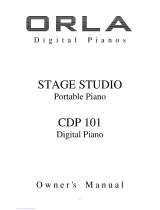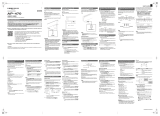
10
Table of ContentsTable of Contents
Important Information
Table of Contents
Important Information
Important Safety Instructions ....................... 3
Introduction .......................................... 8
Owner’s Manual Conventions ....................... 9
Table of Contents ................................... 10
Part Names and Functions .......................... 12
Preparation
Setting Up the Piano ................................14
1 Power ...........................................14
2 Key cover and music rest ........................ 15
3 Opening / closing the lid ........................ 16
4 Volume and headphones ....................... 17
5 Pedals ........................................... 18
Basic Operation
Selecting Sounds .................................... 19
Dual Mode ........................................... 20
Split Mode ........................................... 22
Four Hands Mode ...................................24
Reverb ...............................................26
Eects ...............................................28
Virtual Technician ...................................30
1 Smart Mode .....................................30
2 Advanced Mode ................................ 31
Metronome / Drum Rhythms ....................... 32
Registration Memories .............................. 34
1 Selecting a Registration memory ...............34
2 Storing a Registration memory ................. 35
3 Registration Edit menu .......................... 36
Panel Lock ........................................... 37
Demo Songs .........................................38
Piano Music .........................................39
Lesson Function .....................................40
1 Selecting a lesson book/song ...................40
2 Listening to the selected lesson song ........... 41
3 Lesson Function settings ........................ 42
4 Repeating sections of a lesson song ............ 43
5 Recording a lesson song practice ...............44
6 Finger Exercises .................................45
Concert Magic .......................................46
1 Performing a Concert Magic song ..............46
2 Concert Magic demo mode .....................47
3 Concert Magic settings ..........................48
Steady Beat mode. . . . . . . . . . . . . . . . . . . . . . . . . . . . . . . . . 48
4 Concert Magic song arrangement types ........49
Internal Recorder ...................................50
1 Recording a song ...............................50
2 Playing a song ...................................52
3 Internal Recorder Edit menu ....................53
4 Erasing a part/song .............................54
5 Converting a song to an audio le .............. 55
USB Recorder ........................................ 56
1 Recording an MP3/WAV audio le. . . . . . . . . . . . . . . 56
2 Playing an MP3/WAV audio le .................. 58
3 Recording a MIDI song le ......................60
4 Playing a MIDI song le .........................62
5 USB Recorder Edit menu ........................64
6 Converting a MIDI song le to an MP3/WAV audio
le ............................................65
7 Overdubbing an MP3/WAV audio le ...........66
8 Recording to an existing MIDI song le .........67
Adjustments & Settings
Function menus .....................................68
Basic Settings .......................................69
1 Key Transpose ...................................70
2 Song Transpose .................................71
3 Tone Control ....................................72
User Tone Control .................................73
4 Speaker Volume ................................. 74
5 Tuning ........................................... 75
6 Damper Hold ....................................76
7 Split .............................................77
8 Four Hands ...................................... 78
9 Startup Setting .................................. 79
10 Factory Reset ..................................80
11 Auto Display O ................................ 81
12 Auto Power O .................................82
Virtual Technician Settings .........................83
1 Touch Curve ..................................... 85
User Touch Curve .................................86
2 Voicing ..........................................87
User Voicing .......................................88
3 Damper Resonance .............................89






















